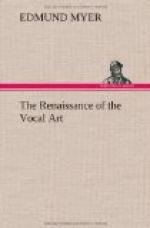Sing the first tone staccato, placing the body upon a level with the tone as described. Then from the level of this first tone, through flexible vitalized action, carry the body spontaneously or by impulse to the level of the upper tone; the air current or the tone should strike the roof of the mouth well forward and instantly reflect into the low cavities. In this way all true conditions are secured, and the voice is allowed to sing instead of being made or compelled. There must be a very free lift, expansion, and let go between the first and the upper tone. Do not let the second tone start until its level is reached, or the effect will be spoiled, or at least modified. All this must be done rhythmically, which means without the least hesitation, or without the sensation of haste. To hesitate compels local effort. To hurry disturbs all true conditions. This is a very valuable exercise, if understood.
[Illustration: SEVENTH STUDY. Ah....]
This study is virtually the same as the sixth, except that the voice is not suspended or arrested between the first and second tones. This exercise must be studied with the same action and the same impulse as the sixth study. Some singers can get placing and reaction better on this study than on the sixth.
[Illustration: EIGHTH STUDY. Ah....]
Find the level of the first tone as suggested, using hands and body; move down, hands and body going with the tone, while singing the first three notes of this exercise; then, without stopping or hesitating, reverse the action or the movement, by lifting hands and body, and opening wide by dropping the lower jaw, while singing the last three notes. Of course the voice must sing from the highest to the lowest note with a continuous legato flow. The movement of the body down with the first three notes and the reverse action, moving up and out on the last three, must be smooth and continuous. If this is done properly the reverse action will give a wonderful sensation of freedom, openness, and the power of low added resonance. It demonstrates forcibly what is meant by placing up and building down.
This is the great idea or the great movement for developing the low tones in all voices. When the low tones are thus developed by expansion, but without effort, the same idea of freedom and low resonance can be carried into the high tones. This can be done especially well and easily on exercises six and seven. The higher the tone the lower the resonance should be if the object be a full beautiful, free tone.
[Illustration: NINTH STUDY. Ah....]
Place yourself upon a level with the first tone as suggested, and allow the tone to start spontaneously, striking, as it were, the roof of the mouth and the chest simultaneously. Move body and hands down with the voice to the low tone, and then instantly but rhythmically, lift back to the level of the upper tone. Feel as though you were under the tone with body and hands in moving up, and let the tone strike by impulse, the roof of the mouth, and instantly reflect into the chest. Practice this exercise until it can be done with perfect freedom of form and action.




